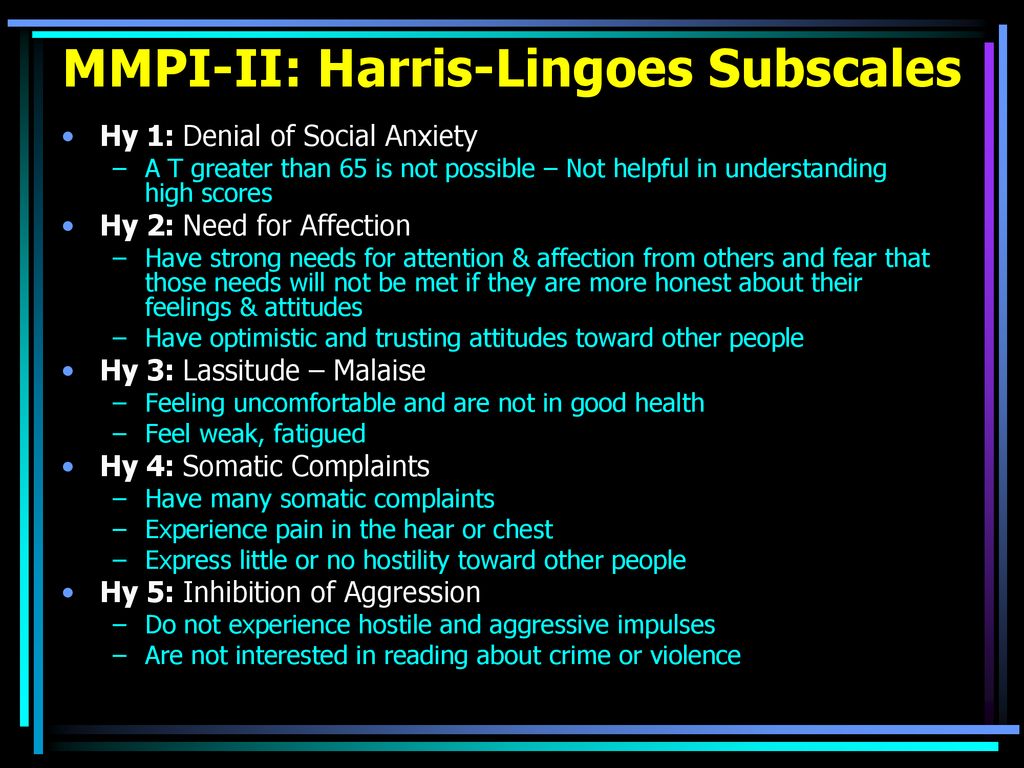
Meehl showed that using actuarial tables to interpret the profiles is a better strategy than clinical interpretation. It is a good idea in this case to interpret not only based on the code-types but also based on the individual profiles and content scales.
#Mmpi 2 code type interpretation code#
There are code types which have scarce empirical descriptors. It is said that discrepancies are minor, but keep them in mind. There may be some slight shifting of scales within the profile code between the two forms because of the difference in standardization samples and T-score transformation procedures. 90% of the profiles with a 5-point profile code definition have the same codes on both interviews.The need to make T scores fall at equivalent percentile values has affected some codes, especially the ones with less of a clear definition.Types are quite consistent between the two types.Similarity of the traditional MMPI and MMPI-2 code types Profile code types that are 4 or fewer points above the next score may shift on later retest but future profiles will probably maintain some elements and correlates of the initial code types. Profile code types that are 5-9 points above the next score are likely to remain constant on retest. Profile code types that are 10 points or more above the next highest score are very likely to be found at retest. Rules of thumb for assessing the stability of a profile code: The greatest code-type agreement at rests was obtained for profiles with a 10-point T-score spread between the code type and the rest of the profile code. On the other hand, codes with more extreme scores (that is those that were well-defined by a substantial point separation between the scale scores in the code type and those not included in the code) tended to be similar at rests. The stability of the codes depends on how well the code is defined and there are reports of low congruence on retest. MMPI has good test-retest reliability, ranging from medium to high.

Same with the difference in elevations of the code types, because the s elevation describes the likelihood that the empirical correlates apply to the case (the higher the elevation, the more confident we can be that the person indeed is exhibiting said behaviours) The order of the scales within the code type might make an important difference regarding the relative importance of empirical descriptors, therefore it’s best to emphasize the correlates of the higher elevated scale of the code type. HOWEVER, both these features do have their own importance in differentiating characteristics. 2-7 and 7-2), ignoring the score level and the rank order of the elevated scales. Researchers grouped similar type codes, to obtain a higher number sample (ex. Typically, a large number of cases is required to obtain a sufficient number of subjects with a particular code. Rather than statistical analyses which have limited application and do not provide a more accurate classification, code types are practical, easy to apply and summarize better the most important elements of a given profile. If a code type is an infrequent one, the scale-by-scale interpretation strategy should be used. There must be sufficient research on behavioural descriptions for the code. The more well-defined the code types is the better there is a match with the correlate literature. 2 or more scales reach interpretative significance using the definitions discussed in the following). The profile should be clearly defined) i.e. 1-2-3-4 can be found in medical settings. 2-4-7, found in alcohol- and drug-treatment programs).įour-point code is relatively rare. Three-point code (frequent in different areas of research) occurs when 3 clinical scales are elevated in the profile (ex. The code defining such an occurrence would be something like 2-7/7-2. Two point profile (more frequently researched): 2 clinical scales are elevated in the critical range (T≥65).

Single profile (profile spike): one single standard scale if elevated in the critical range. Scales most included in the research on code types: Hs, D, Hy, Pd, Pa, Pt, Sc, Ma.įor research on special populations include other scales, such as Mf and Si. They are based on the analysis of scale patterns.Ī code type is defined by the highest elevated scale or scales in the standard profile and their rank order in terms of elevation.

Profile or code types are MMPI-2 clinical scale summary indexes that include the most prominent scale elevations in a configuration of the standard MMPI-2 scales.Ĭode-type interpretation was developed as recognition that in many cases, more than one standard scale was usually elevated. INTERPRETING MMPI-2 PROFILE TYPES (CODE TYPES)


 0 kommentar(er)
0 kommentar(er)
